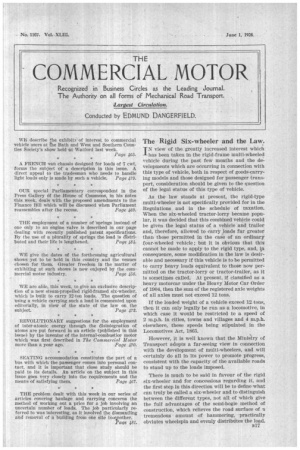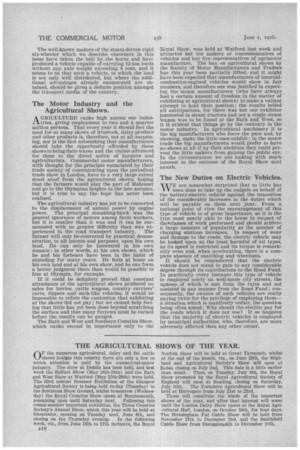The Rigid Six-wheeler and the Law.
Page 1

Page 2

If you've noticed an error in this article please click here to report it so we can fix it.
IN view of the greatly increased interest which has been taken in the rigid-frame multi-wheeled vehicle during the past few months and the developments which are occurring in connection with this type of vehicle, both in respect of goods-carrying models and those designed for passenger transport, consideration should be given to the wiestion of the legal status of this type of vehicle.
As the law stands at present, the rigid-type multi-wheeler is not specifically provided for in the Regulations and in the schedule of taxation. When the six-wheeled tractor-lorry became popular, it was decided that this combined vehicle could be given the legal status of a vehicle and trailer and, therefore, allowed to carry loads far greater than those permitted in the case of an ordinary four-wheeled vehicle ; but it is obvious that this cannot be made to apply to the rigid type, and, in consequence, some modification in the law is desirable and necessary if this vehicle is to be permitted to carry heavy loads equivalent to those now permitted on the tractor-lorry or tractor-trailer, as it is sometimes called. At present, if classified as a heavy motorcar under the Heavy Motor Car Order of 1904, then the sum of the registered axle weights of all axles must not exceed 12 tons.
If the loaded weight of a vehicle exceed 12 tons, then it can only legally be run as a locomotive, in which case it would be restricted to a speed of 2 m.p.h. in cities, towns and villages and 4 m.p.h. elsewhere, these speeds being stipulated in the Locomotives Act, 1805, However, it is well known that the Miniary of Transport adopts a far-seeing view in connection with the development of multi-wheelers, and will certainly do all in its power to promote progress, consistent with the capacity of the available roads to stand up to the loads imposed.
There is much to be said in favour of the rigid six-wheeler and for concessions regarding it, and the first step in this direction will be to define what can truly be called a six-wheeler and to distinguish between the different types, not all of which give the full advantages of the semi-bogie method of construction, which relieves the road surface of n tremendous amount of hammering, practically obviates wheelspin and evenly distributes the load. The well-known makers of the steam-driven rigid six-wheeler which we describe elsewhere in this issue have taken the bull by. the horns and have produced a vehicle capable of carrying 12-ton loads without any axle weight exceeding 8 tons, and it seems to us that such a vehicle, in which the load is not only well distributed, but where the additional advantages already enumerated are obtained, should be given a definite position amongst the transport media of the country.
The Motor Industry and the Agricultural Shows.
A GRICULTURE ranks high among our indusIA-tries, giving employment to two and a quarter million persons. That every year it should feel the need for so many shows of livestock, dairy produce and other products is, therefore, not at all surprising, nor is the fact astonishing that manufacturers should take the opportunity afforded by ' these shows to bring their wares and the claims advanced for them to the direct notice of farmers and agriculturists. Commercial motor manufacturers, with thought for the principle enunciated by their trade society of concentrating upon the periodical trade show in London, have to a very large extent stood aloof from the agricultural shows, hoping that the farmers would play the part of Mahomet and go to the Olympian heights in the late autumn, but it is true to say the hope has never been realized.
The agricultural industry has yet to be converted' to the displacement of animal power by engine power. The principal stumbling-block was the general ignorance of motors among farm workers, but it is smaller than it was and it can be surmounted with no greater difficulty than was experienced in the road transport industry. The farmer will only be...converted by practical demonstration, to all intents and purposes, upon his own land. He can only be interested in his own domain ; in other words, at his own shows, which he and his forbears have been in the habit of attending for many years. He feels at home on his own land and at his own show, and he can form a better judgment there than would be possible to him at Olympia, for example.
If it could be definitely proved that constant attendance at the agricultural shows produced no sales for lorries, cattle wagons, country carriers' carts, tippers and such-like vehicles, it would be impossible to refute the contention that exhibiting at the shows did not pay; but we cannot help feeling that little has yet been done beyond scratching the surface and that many furrows must be turned before the results can be gauged.
The Bath and West and Southern Counties Show, which ranks second in importance only to the Royal Show, was held at Watford last week and attracted but ten makers or concessionnaires of vehicles and but five representatives of agrimotor manufacture. The ban on agricultural shows by the Society of Motor Manufacturers and Traders has this year been partially lifted, and it might have been expected that manufacturers of internalcombustion-engined vehicles would show in fair numbers, and therefore one was justified in expecting the steam manufacturers (who have always had a certain amount of freedom in the matter of exhibiting at agricultural shows) to make a valiant attempt to hold their position ; the results belied all anticipations, for there was but one exhibitor interested in steam tractors and not a single steam Wagon was to be found at the Bath and West, so it is evident that things go by the contrary in the motor industry. In agricultural machinery it is the big manufacturers who force the pace and, by showing, make the little ones exhibit ; in the motor trade the big manufacturers would prefer to have no shows at all if by their abolition they could prevent the little makers from gaining the public eye. In the circumstances we are looking with much interest to the outcome of the Royal Show next mouth.
The New Duties on Electric Vehicles.
WE are somewhat surprised that so little has been done to take up the cudgels on behalf of the battery-electric vehicle against the imposition of the considerable increases in the duties which will be payable on them next year. From a national point of view the encouragement of this type of vehicle is of great importance, as it is the type most nearly akin to the horse in respect of thetclasses of work performed and should achieve a large measure of popularity as the number of charging stations increases. In respect of wear and damage to the roads, the electric vehicle may be looked upon as the least harmful of all types, as its speed is restricted and its torque is remarkably even and, when accelerating, there is a complete absence of snatching and wheelspin.
It should be remembered that the electric vehicle does not stand to gain to any considerable degree through its contributions to the Road Fund. In practically every instance this type of vehicle is employed solely on well-made city streets, the upkeep, of which is met from the rates and not assisted in any manner from the Road Fund ; consequently, the owners of such vehicles are really paying twice for the privilege of employing them— a situation which Is manifestly unfair, the question being often asked : Why should the electric pay for the roads which it does not use? It so happens that the majority of electric vehicles is employed by municipal authorities, who, therefore, are more adversely affected than any other owner.




























